more memories for mina
 First of all I'd like to thank Steve Lucas for keeping so many photos of old set designs that I've worked on in his website portfolio. These first two are from Jump, which won a Dora Award for design in 1992, if I recall correctly. I didn't design anything but I did construct a steel ladder which is barely visible behind the cluster of actors. It was painted red and stretched twenty feet from the floor of the stage to the lighting grid. It was hidden behind the closed curtain for most of the play, which was acted on what might be termed the proscenium, although the Theatre Passe Muraille backspace has never been a proscenium theatre.
First of all I'd like to thank Steve Lucas for keeping so many photos of old set designs that I've worked on in his website portfolio. These first two are from Jump, which won a Dora Award for design in 1992, if I recall correctly. I didn't design anything but I did construct a steel ladder which is barely visible behind the cluster of actors. It was painted red and stretched twenty feet from the floor of the stage to the lighting grid. It was hidden behind the closed curtain for most of the play, which was acted on what might be termed the proscenium, although the Theatre Passe Muraille backspace has never been a proscenium theatre.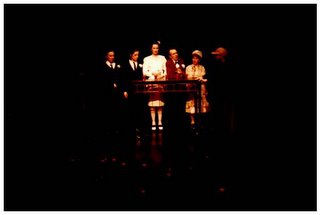 I also cut the steel rods for the ladder trim on the other furniture, but was unable to weld it myself as I was leaving for Amsterdam to research an essay on Rembrandt at the Rijks museum.
I also cut the steel rods for the ladder trim on the other furniture, but was unable to weld it myself as I was leaving for Amsterdam to research an essay on Rembrandt at the Rijks museum.I was in my second year of university at the time.
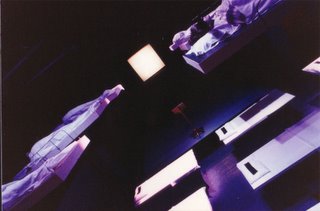 The next year just before Christmas I returned from my exchange to Newcastle in time to work on constructing the set for Sleeproom, which was a bit of environmental theatre staged in the entire Theatre Passe Muraille building. In the mainspace Steve's design called for an array of hospital beds hanging from the ceiling.
The next year just before Christmas I returned from my exchange to Newcastle in time to work on constructing the set for Sleeproom, which was a bit of environmental theatre staged in the entire Theatre Passe Muraille building. In the mainspace Steve's design called for an array of hospital beds hanging from the ceiling. I arc-welded some frames for the aircraft cable and the beds' (chintzy) handrails in the TPM shop. Having never arc-welded before, I asked Stephen George how to set the amperage. He got Graham Greene of the Dances with Wolves best supporting actor Oscar on the phone. It seems that Graham had done a lot of welding for TPM during the renovations when they acquired their building. He was at a Christmas party but spared a few minutes to instruct me that the amperage should be increased until the arc sounded like the crackling of frying eggs. To this day that's my one and only conversation with an Oscar winner.
I arc-welded some frames for the aircraft cable and the beds' (chintzy) handrails in the TPM shop. Having never arc-welded before, I asked Stephen George how to set the amperage. He got Graham Greene of the Dances with Wolves best supporting actor Oscar on the phone. It seems that Graham had done a lot of welding for TPM during the renovations when they acquired their building. He was at a Christmas party but spared a few minutes to instruct me that the amperage should be increased until the arc sounded like the crackling of frying eggs. To this day that's my one and only conversation with an Oscar winner.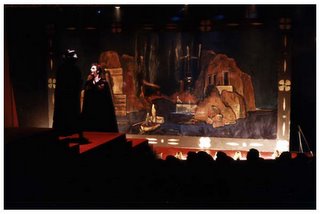 It was 1993 I think when Steve introduced me to a director named Steven Seabrook. I think this was the first of his shows that I worked on, called Dance of Death. It's a Strindberg play that was mounted at Harbourfront. This first photo is a best possible image of my scrim painting, the first I ever attempted. It's a rough rendition of the painting The Isle of the Dead by Arnold Bocklin. Here's the link to his five versions: http://www.stmoroky.com/reviews/gallery/bocklin/iotd.htm
It was 1993 I think when Steve introduced me to a director named Steven Seabrook. I think this was the first of his shows that I worked on, called Dance of Death. It's a Strindberg play that was mounted at Harbourfront. This first photo is a best possible image of my scrim painting, the first I ever attempted. It's a rough rendition of the painting The Isle of the Dead by Arnold Bocklin. Here's the link to his five versions: http://www.stmoroky.com/reviews/gallery/bocklin/iotd.htm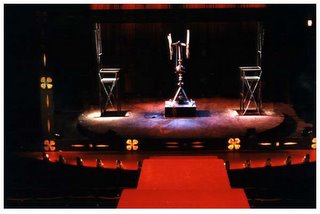 The way a scrim works is this: when it's lit from in front it appears as a wall, and when there is a light behind it (not on it, though!) it becomes invisible as in this photo. People have projected images on them before, but as they are very expensive I am not aware that anyone else has painted them. I did paint three more for a music video a few years later. The art director I worked with went on to work on a few David Bowie videos. She was the the best friend I had in the music video business, so she's welcome to the technique I developed if she's ever used it again. I never saw the video so I'm not sure if it worked or not.
The way a scrim works is this: when it's lit from in front it appears as a wall, and when there is a light behind it (not on it, though!) it becomes invisible as in this photo. People have projected images on them before, but as they are very expensive I am not aware that anyone else has painted them. I did paint three more for a music video a few years later. The art director I worked with went on to work on a few David Bowie videos. She was the the best friend I had in the music video business, so she's welcome to the technique I developed if she's ever used it again. I never saw the video so I'm not sure if it worked or not. These next two photos are of sets that I painted. I was also prop designer for the first one, another Seabrook show called Mouth written by the nicest playwright I know, Robin Fulford. The design was meant to approximate the inside of a human mouth. Notice how light filters through the canvas. Most action took place downstage. The lead role was played by Park Bench, of mental health awareness advertising fame. Staged in tandem with Mouth was another show called Cafe Naked. It was a lame Seinfeld imitation with the one highlight being Lisa Ryder of Canadian television reknown appearing naked at the end for no apparent reason. I painted the stage floor to resemble an actual wooden floor, something I had previously done in my own design for Anastasia is Alive and Well and Living with her Brother, the Tsar by the inimitable Glenn Christie, for whom I was a human lampstand in my first professional Toronto stage appearance.
These next two photos are of sets that I painted. I was also prop designer for the first one, another Seabrook show called Mouth written by the nicest playwright I know, Robin Fulford. The design was meant to approximate the inside of a human mouth. Notice how light filters through the canvas. Most action took place downstage. The lead role was played by Park Bench, of mental health awareness advertising fame. Staged in tandem with Mouth was another show called Cafe Naked. It was a lame Seinfeld imitation with the one highlight being Lisa Ryder of Canadian television reknown appearing naked at the end for no apparent reason. I painted the stage floor to resemble an actual wooden floor, something I had previously done in my own design for Anastasia is Alive and Well and Living with her Brother, the Tsar by the inimitable Glenn Christie, for whom I was a human lampstand in my first professional Toronto stage appearance. 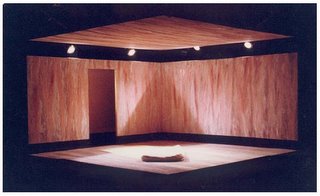 As with Mouth, Two Rooms was mounted at the incarnation of The Theatre Centre which was downstairs from the legion hall across from the Queen West Mental Health Centre for several years. As often happens, the director saw a previous design of Steve's and requested him to do something similar. All I did was paint the walls and it took exactly fourteen hours, didn't it Steve?
As with Mouth, Two Rooms was mounted at the incarnation of The Theatre Centre which was downstairs from the legion hall across from the Queen West Mental Health Centre for several years. As often happens, the director saw a previous design of Steve's and requested him to do something similar. All I did was paint the walls and it took exactly fourteen hours, didn't it Steve?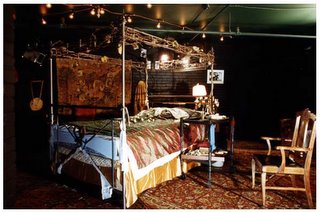 This is a photo of the stage/house for The Last Supper, an award-winning Hillar Liitoja play starring Ken MacDougall, Sky Gilbert and Jim Allodi. I have worked on a few DNA shows but for this one all I really did was make a drawing of the TPM backspace booth which was entirely taken apart and subsequently reassembled. Steve was once again impressed, this time by my rudimentary drafting skills. Thanks dad. The audience was limited to twenty or so and they all clustered around the walls, though they were free to roam throughout the space as with all of Hillar's shows. This one won a Chalmer's award for best play, I think. Ken, whom I greatly admired and respected, succumbed to his illness too soon afterwards, leaving a directing and acting legacy for Torontonians to cherish.
This is a photo of the stage/house for The Last Supper, an award-winning Hillar Liitoja play starring Ken MacDougall, Sky Gilbert and Jim Allodi. I have worked on a few DNA shows but for this one all I really did was make a drawing of the TPM backspace booth which was entirely taken apart and subsequently reassembled. Steve was once again impressed, this time by my rudimentary drafting skills. Thanks dad. The audience was limited to twenty or so and they all clustered around the walls, though they were free to roam throughout the space as with all of Hillar's shows. This one won a Chalmer's award for best play, I think. Ken, whom I greatly admired and respected, succumbed to his illness too soon afterwards, leaving a directing and acting legacy for Torontonians to cherish.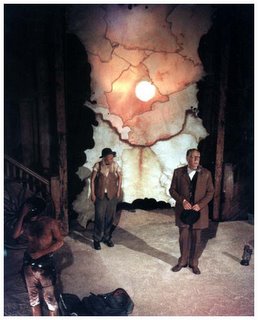 This last photo takes me full circle. I was back in Toronto for three months in 1998, and Steve once again asked me to help him out with a special task. He needed a lighting instrument that could approximate a rising sun. Here it is. Easy Lenny Lazman and the Great Western Ascension won a Dora for lighting design. It was staged at the Annex Theatre where I first broke into Toronto theatre. My special instrument was considered unique by the stage manager and she even suggested that I patent it. It was seen again at the Factory Theatre in a show lit by Rebecca Picherack, that time as a moon. Rebecca's an acclaimed lighting designer in her own right these days, although she doesn't seem to have much time for old acquaintances who built the lovers' bed with her for Die in Debt's Romeo and Juliet under the Bathurst Street Bridge.
This last photo takes me full circle. I was back in Toronto for three months in 1998, and Steve once again asked me to help him out with a special task. He needed a lighting instrument that could approximate a rising sun. Here it is. Easy Lenny Lazman and the Great Western Ascension won a Dora for lighting design. It was staged at the Annex Theatre where I first broke into Toronto theatre. My special instrument was considered unique by the stage manager and she even suggested that I patent it. It was seen again at the Factory Theatre in a show lit by Rebecca Picherack, that time as a moon. Rebecca's an acclaimed lighting designer in her own right these days, although she doesn't seem to have much time for old acquaintances who built the lovers' bed with her for Die in Debt's Romeo and Juliet under the Bathurst Street Bridge.I think that's enough nostalgia for one post. I hope this assists you in your inspiration, Mina.
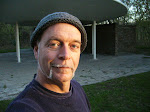
1 Comments:
yes 14 hours. Exactly.
wow, nice to see somebody remembers all that stuff. Hey! what about the 100 trees for Wildboy!
Post a Comment
<< Home